Casting: The Die of Eros
. . .males and females are cast in the same mold.
—Michel Eyquem de Montaigne
The transitive nature of the nude in Given , its "passage," becomes explicit once we examine the nude in the context of the scene, framed by the brick wall through which it is perceived. This brick wall also acts as a screen, blocking a view, already restricted by the peepholes of Given . This wall marks the site of an ambiguous passage, since it is unclear whether the break in the wall acts as a "doorway" for the nude or whether it is more like a window whose solid frame impedes the viewer's visual perception of the scene.[27] This inability to distinguish the function of the frame as a foreground or as a background element is present in a lithograph, contemporary to Given , from the same series mentioned above, entitled The Bride Stripped Bare . . . (February 1968). In this lithograph a female nude crouches, surrounded by an aura that makes the figure look like a cutout, rendering its outline undecidable as far as questions of foreground or background are concerned. This allusion to the visual aura of the figure can also be seen as a pun on The Bec Auer (fig. 75), a lithograph in the same series, of a female figure holding a gas lamp whose outline is disrupted by the superimposition of a male figure cradling his head in his hands. These two lithographs are visual and verbal allusions to the aura (nimbus shape) outlined in the wall, framing our vision of Given . The opening in the brick wall acts as a doorway, whose shape frames and thus brings the visible into view, while bracketing it off as a screen.
This carved brick aperture brings to mind yet another example of Duchamp's doors, his Door for Gradiva (Porte pour Gradiva ; 1937) (fig. 77), a glass door for André Breton's gallery, destroyed at Duchamp's request when the gallery closed down. A drawing of this door, Sketch of "Door for Gradiva ," depicts the silhouette of a couple of enlaced lovers as a cutout. Resembling René Magritte's painting The Unexpected Answer (La Réponse imprévue ; 1933), Duchamp's door—like Magritte's—is ambiguous, since it is closed while bearing the outline of an aperture. Duchamp's Door for Gradiva presents yet another instance of a "hinge," since its transparence outlines an undecidable passage. This glass door thus functions as a visual pun that affirms incompatible realities. It acts as a hinge demarcating the play of the door as site of both opening and closure, a transparent surface opening onto a space only to block entry into
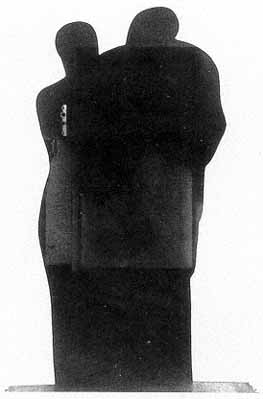
Fig. 77.
Marcel Duchamp, Door for Gradiva (Porte pour Gradiva),
1968 (original version of 1937, Paris, destroyed). Plexiglass,
78 x 52 in. Hessisches Landesmuseum, Darmstadt.
Courtesy of Arturo Schwarz.
it. The outline of this couple in profile confuses the viewer's perception by its reversible character, since it is impossible to distinguish the inside from the outside and depth from surface. This glass door that frames the viewer's field of vision, like the brick wall in Given , brings the visible into view only to draw attention to its limited character.
Door for Gradiva thus acts as a "hinge," whose liminal surface alludes to Duchamp's exploration in his Notes of the "infrathin" (infra mince ) principle (Notes , 9–10). The "infrathin" is defined as a surface that acts both as a separating interval and a screen: "infrathin separation—better/ than screen, because it indicates/ interval (taken in one sense) and/ screen (taken in another sense)—separation has the 2 senses male and female—" (Notes , 9). The infrathin is both a surface and an interval, whose deictical character points in two different directions at the same time. Its ambiguous
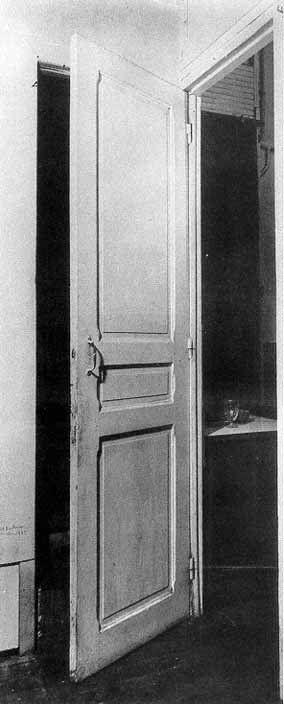
Fig. 78.
Marcel Duchamp, Door: 11, Rue Larrey (Porte: 11, Rue
Larrey), 1927. Three-dimensional pun: a door that
permanently opens and shuts at the same time, made
by a carpenter after Duchamp's design, 86 5/8 x 24 11/16 in.
Collection Arman, New York. Courtesy of Arturo Schwarz.
nature prefigures the role of eroticism in Given , as the "index mark" of the androgynous sexuality of the nude, pointing in two different senses, or sexes (male and female), at the same time.[28] The opening in the brick wall in Given can thus be understood according to the logic of the "infrathin" principle, acting as the hinge to what is seen (a pun on "thin") in Given . This hinge opens onto two directions in the erotic scene of Given , like Duchamp's Door: 11, rue Larrey (fig. 78), indicating that sexuality is "hinged" on the reversibility of the male and female positions.[29] Sexuality is presented, therefore, as an interplay whose ambiguous indexical character resituates the notion of sexual difference and its equation with visibility.
Duchamp's definition of the "infrathin" suggests that this principle may also be applied to the nude in Given , insofar as it is a mold. Commenting on molds, Duchamp observes the same principle of infrathin separation: "2 forms cast in/ the same mold(?) differ/ from each other/ by infra thin separative/ amount" (Notes , 35). The molded character of the nude (its lifelike sculptural dimension) erases the separation between life and death through an imperceptible, artificial difference. This difference that marks the nature of the mold is summarized by Anne d'Harnoncourt as follows: "The paradox of an impression taken from life, captured in lifeless material, works to create a form of realism that seems highly artificial, so intimately related to the real thing and yet so remote."[30] This artificial separation between life and death stages their difference as "hinged" on the principle of their "infra-thin" separation. The mold is "the (photographic) negative," a negative impression "from the perspective of form and color," as Duchamp observes in his notes to the White Box (In the Infinitive, [WMD , 85]). The photographic aspects of the molded nude in Given thus allude to its artificiality not merely as an object but also as an art object. In this work Duchamp plays with the concept of art, insofar as its modes of impression (apparition), photographic or sculptural, highlight the contrived "look" of the nude, its hyperreality.
This analysis of the nude as a mold is reinforced by Duchamp's implicit allusion to molds in Door for Gradiva , since the imprint of Gradiva's existence, the trace of her apparition, is preserved in a mold. The notion of the mold is embedded in the reversible hinge character of the wall in Given serving as a further reflection on the transitive nature of
the eroticism of the nude. The nude is a mold, and thus a "ready-made," a form molded on another, similar and yet different from itself. The "infrathin" separation between the model and its copy becomes the site (a pun on sight) of the fragile interval separating a body from its impression, life from art, a work of art from its copy. In Given this "infrathin" separation becomes the deceptive and reversible interval of sexual difference.
Duchamp's obsession with molds, captured in such objects as Female Fig Leaf (fig. 79), Dart-Object (fig. 80), and Wedge of Chastity (Coin de chasteté ; 1954) (fig. 81), can be seen as yet another exploration of his theories elaborated through the notion of the "infrathin." These figures turn eroticism inside out like a glove. Sexuality emerges as the obverse trace of the female sex molded negatively by the imprint of the female body, as in Female Fig Leaf . In Dart-Object the protrusive presence of the "dart" (simulated riblike phallus) suggests the outward projection of an absence as a positive shape. Jean Clair notes that in Dart-Object gender is envisaged as a break (coupure ), as a division within being, as a lack that is but the effect in three-dimensional space, of a four-dimensional projection. In other words, he suggests that gender is merely the effect of an ironic causality, that of a system of projection whose laws challenge the conventional rationale both of conventional geometry and the gendered gaze.[31]
The conjunction of the male and female positions is made explicit by Duchamp in Wedge of Chastity , where both shapes are embedded in each other. The concavity of "femininity" is welded to the convexity of "maleness" in the outline of the wedge, yet another "hinge" by which Duchamp marks the liminal character of sexuality. The two shapes emerge as
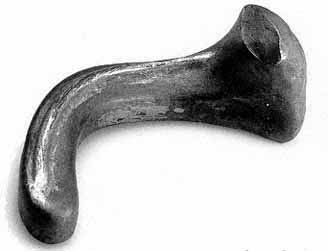
Fig. 79,
Marcel Duchamp, Female Fig Leaf (Feuille de Vigne Femelle),
1950. Galvanized plaster, 3 1/2 x 5 1/2 x 4 7/8 in.
Courtesy of The Philadelphia Museum of Art, gift of Mrs.
Marcel Duchamp.
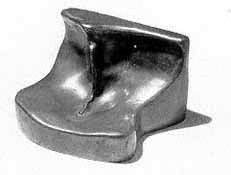
Fig. 80,
Marcel Duchamp, Dart-Object (Objet-Dard), 1951.
Galvanized plaster with inlaid lead, 3 x 8 x 2 3/8 in.
Courtesy of The Philadelphia Museum of Art, gift of
Mrs. Marcel Duchamp.
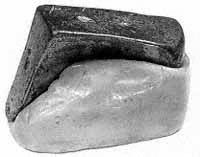
Fig. 81.
Marcel Duchamp, Wedge Of Chastity (Coin De
Chasteté), 1954. Sculpture of two interlocking parts,
galvanized plaster for the wedge and dental plastic
for the base, 2 1/4 x 3 3/8 in.
Courtesy of The Philadelphia Museum of Art.
reversible molds of each other, an interpenetration of forms that informs their interpretation. This visual and discursive ambiguity that marks Duchamp's representation of sexuality is elucidated by his comment on the Wedge of Chastity as "the meaning of the wedge driven in (like a nail), not the place" (le sens du coin qui s'enfonce, pas le lieu ).[32] The word enfoncer also means breaking open a door, thus referring explicitly to the ambiguous character of the door in Given , which is both broken open and shut with nails, at the same time. The wedge as a corner (coin, in French) in Wedge of Chastity becomes the mark of sexual difference through coitus (coit , in French), a turning point that through reiteration marks the objective "coincidence" (or is it "coitcidence"?) of the male and the female positions.
This pun on eroticism as a wedge, corner, and turning point, is made explicit in Duchamp's Anemic Cinema (Anémic Cinéma; 1925–26) (fig. 82), where the anagram on the rotary disk "Have you ever put the marrow of the sword into the stove of the loved one?" (Avez vous déjà mis la moëlle de l'épée dans le poêle de l'aimée? ) captures, through the spiraling movement of the disk, the visual and literary convergence of the male and female positions as puns on the "sword/penis" and the "stove/vagina." The figure of sexuality is here dubbed through further wordplays on stove (le poêle , which in French also means a shroud that covers the dead).[33] This process of bilingual dubbing inscribes death within eros as its obverse. Commenting on the effect of the movement of the spiral on the viewer, Duchamp remarks that "The spiral at rest doesn't give/ any impression of relief/ (or at least only imagined/ psychologically)/" (Notes , 170). Duchamp's observation confirms the vertiginous conflation of sexuality
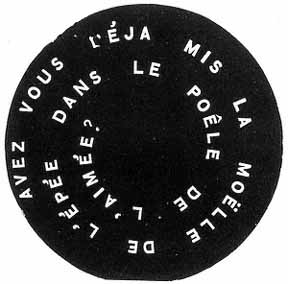
Fig. 82.
Marcel Duchamp, Anemic Cinema (Anémic Cinéma),
1925–26. Film made in collaboration with Man Ray and
Marc Allégret. Ten optical discs alternated with nine
discs with puns. Courtesy of Arturo Schwarz.
and death, as motion (life) and rest (death) converge in the rotation of the spiral.
In the quote above Duchamp also suggests that the spiraling movement of the rotoreliefs is connected with the visual illusion of relief, thereby suggesting the affinity of motion to both molds and photographic negatives. Likewise, the puns on "la moëlle de l'épée " and "lepoêle de l'aimée " converge anagrammatically, signifying the reduction of sexual difference to indifference.[34] This punning visual and literary play in Anemic Cinema helps elucidate the status of eroticism in Given . It suggests that sexual difference cannot be understood as a difference intrinsic to the body, as a set visual and discursive signifier, but rather that "difference" is merely the illusory effect of movement, that is to say, shifts in the rotation of the body as a punning "hinge." Thus sexual difference in Given emerges not as an anatomical fact but rather as the projection of the gaze of the spectator that attempts to "fix" and thus put to rest the androgynous appearance of the nude. The nude is merely a "hinge," a figurative device that acts like a pun, swinging back and forth between the male and female positions. Consequently, Given stages the gaze as a mechanical illusion whose "truth" is no more real than the reality of puns.[35]
The visual seduction operated by the nude in Given can be considered as the "collapsible approximation" (one that can be taken to pieces, dismantled) (l'approximation démontable ), that is, a seduction that is undone by the way in which it is set up. As Duchamp specifies in his instructions to Given , "By approximation I mean a margin (or edge) of ad libidum (a play on libido and male genitalia) in the dismantling (dismounting) and the remantling" (remounting) ("Par approximation j'entends une marge d'ad libitum dans le démontage et remontage ").[36] The gaze of the viewer is dismantled by the very spectacle that stages it as an assemblage of puns that simulate sexuality. The sexual connotation of the work is undone by its contextual character, since the nude is not a static object but a "hinge" to an assemblage of visual and literary puns. Given presents an assemblage (montage ) of visual, literary, and institutional givens , whose play, as contextual frames of reference, dismantles the reality of vision, bringing out its approximate nature as the "hinge" between appearance and apparition.